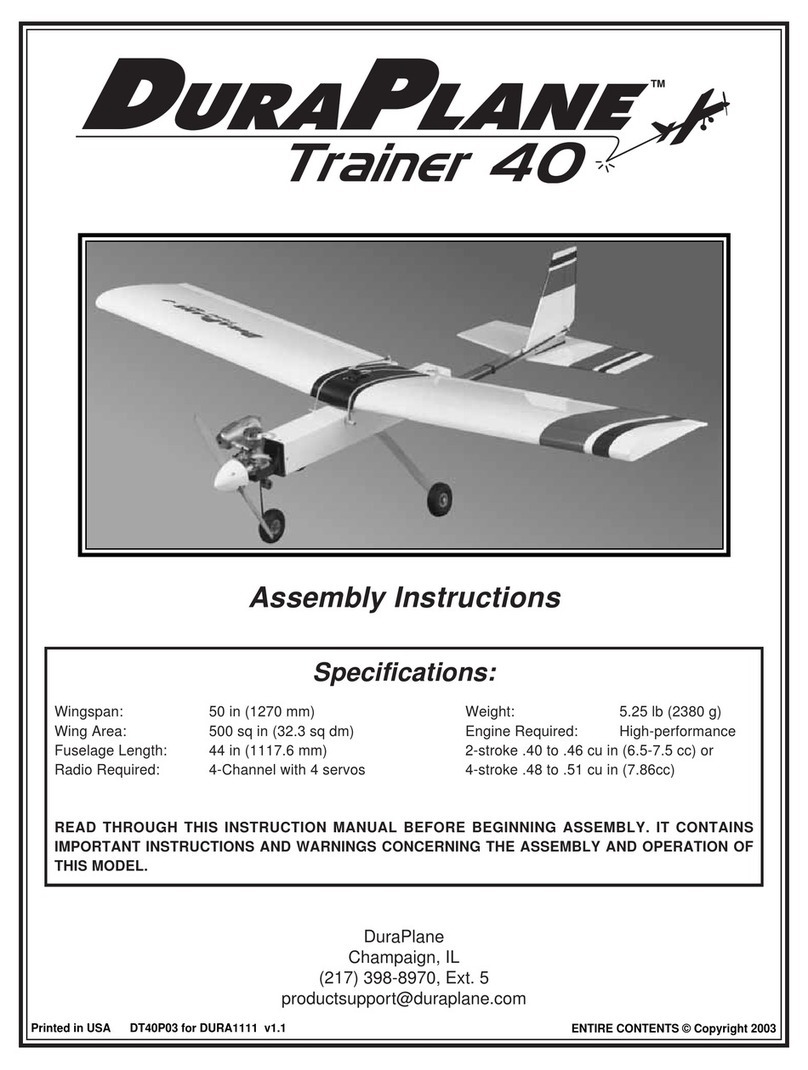
Thank you for purchasing the DuraPlane DuraStik 40 The
DuraStik 40 is the thirdgeneration of DuraPlane models
specificallydesignedforaerobaticflightThestick
configuration isreminiscent of the popular Great Planes stik""
series and isa perfect subject fora fastbuilding aerobatic,
fun flying DuraPlane model Because the DuraStik 40 isfully
aerobatic featuring a wing that has nodihedral (and does not
possess the self-righting characteristics found ina trainer), it
isrecommended that you donotattempt to fly the DuraStik
40asyour first model.
Ifthis isyour first model, the best way to learn to flyR/C is
to joina flyingclub The Academy of Model Aeronautics is
thenationalorganizationthatchartersmodelclubs,
sanctions competitions, and insures flyingfieldsacross the
United States We urge you to jointhe AMA Membership
willbringyouflyinginsurance,a subscriptiontoModel
Aviation Magazine, and many other benefits The AMA will
gladly send you membership information and lists of AMA
chartered clubs inyour area where you can seek the help
of experienced modelers.
Academy of ModelAeronautics
5151 East Memorial Drive
Muncie, Indiana 47302-9252
(800) 435-9262
FAX (765) 741-0057
Web Site:HTTP.//WWW.MODELAIRCRAFT.ORG
Your hobby shop isalso an invaluable place forservice,
partsand informationthatyourequireWe urgeyouto
patronize your local hobby dealer - hes thereto help you
enjoy your hobby.
#11Blades(HCAR0311, 100qty.)
Razor Plane (MASR1510)
Standard and Phillips screwdrivers
Needle nose pliers
Electric drill
Drill Bits 1/16", 3/32", 7/64", 1/8",5/32",
#19 (or 11/64"), 3/16", 15/64" (or 1/4")
X-Acto Building Square (XACR7726)
Kyosho Lexan Curved Scissors (KYOR1010)
Masking Tape
Waxed paper
TopFliteSealing Iron (TOPR2100)
Top Flite "HotSock"(TOPR2175)
Easy-Touch"BarSanders"
Great PlanesC G Machine (GPMR2400)
*A flat,durable, easy to handle sanding toolis a necessity
forbuilding a wellfinished model Great Planes makes a
completerangeof Easy-TouchBar Sanders(patent
pending) and replaceable Easy-Touch Adhesive-Backed
Sandpaper While building the DuraStik, we used a 5-1/2"
BarSander and an11" BarSander equipped with 80-grit
and150-grit Adhesive-backed Sandpaper.
This instruction manualprovides step-by-step instructions for
assembling the DuraStik 40 kit Assembly of the DuraStik 40
consists of six majorsteps,completed inthe following order
BUILDTHETAIL FEATHERS..................................4
ASSEMBLE THE FUSELAGE...................................6
RADIO INSTALLATION
............................................9
BUILD
THE
WING
...................................................12
COVER THE WING AND TAIL................................15
FINAL ASSEMBLY..................................................17
FLIGHT....................................................................19
Here's the complete listof Easy-Touch BarSanders and
Adhesive BackedSandpaper.
5-1/2" Bar Sander (GPMR6169)
11" BarSander (GPMR6170)
22" Bar Sander (GPMR6172)
33" BarSander (GPMR6174)
44"BarSander (GPMR6176)
Adhesive-backed 12' roll of:
80-grit (GPMR6180)
150-grit (GPMR6183)
180-grit (GPMR6184)
220-grit (GPMR6185)
Assortment pack of 5-1/2" strips (GPMR6189)
We use3M 320-grit wet-or-dry sandpaperfor finish sanding.
2





























